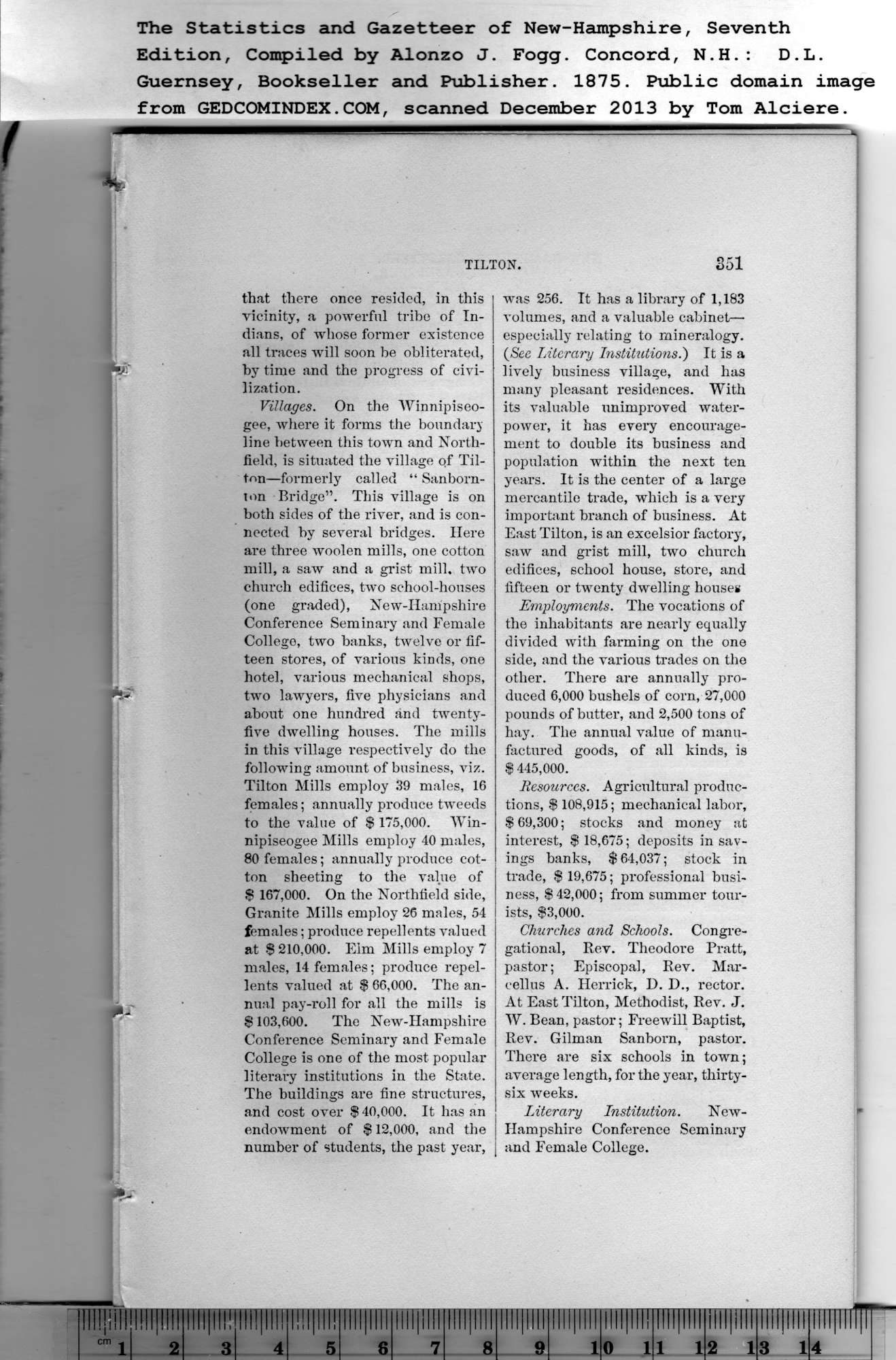|
that there once resided, in this
vicinity, a powerful tribe of In-
dians, of whose former existence
all traces will soon be obliterated,
by time and the progress of civi-
lization.
Villages. On the Winnipiseo-
gee, where it forms the boundary
line between this town and North-
field, is situated the village of Til-
ton—formerly called “ Sanborn-
lon Bridge”. This village is on
both sides of the river, and is con-
nected by several bridges. Here
are three woolen mills, one cotton
mill, a saw and a grist mill, two
church edifices, two school-houses
(one graded), New-IIampshire
Conference Seminary and Female
College, two banks, twelve or fif-
teen stores, of various kinds, one
hotel, various mechanical shops,
two lawyers, five physicians and
about one hundred and twenty-
five dwelling houses. The mills
in this village respectively do the
following amount of business, viz.
Tilton Mills employ 39 males, 16
females; annually produce tweeds
to the value of $ 175,000. Win-
nipiseogee Mills employ 40 males,
80 females; annually produce cot-
ton sheeting to the value of
$ 167,000. On the Northfield side,
Granite Mills employ 26 males, 54
females; produce repellents valued
at $ 210,000. Elm Mills employ 7
males, 14 females; produce repel-
lents valued at $ 66,000. The an-
nual pay-roll for all the mills is
$ 103,600. The New-Hampshire
Conference Seminary and Female
College is one of the most popular
literary institutions in the State.
The buildings are fine structures,
and cost over $ 40,000. It has an
endowment of $ 12,000, and the
number of students, the past year,
was 256. It has a library of 1,183
volumes, and a valuable cabinet—
especially relating to mineralogy.
{See Literary Institutions.) It is a
lively business village, and has
many pleasant residences. With
its valuable unimproved water-
power, it has every encourage-
ment to double its business and
population within the next ten
years. It is the center of a large
mercantile trade, which is a very
important branch of business. At
East Tilton, is an excelsior factory,
saw and grist mill, two church
edifices, school house, store, and
fifteen or twenty dwelling houses
|
Employments. The vocations of
the inhabitants are nearly equally
divided with farming on the one
side, and the various trades on the
other. There are annually pro-
duced 6,000 bushels of corn, 27,000
pounds of butter, and 2,500 tons of
hay. The annual value of manu-
factured goods, of all kinds, is
$ 445,000.
Resources. Agricultural produc-
tions, $ 108,915; mechanical labor,
$69,300; stocks and money at
interest, $ 18,675; deposits in sav-
ings banks, $ 64,037; stock in
trade, $ 19,675; professional busi-
ness, $42,000; from summer tour-
ists, $3,000.
Churches and Schools. Congre-
gational, Rev. Theodore Pratt,
pastor; Episcopal, Rev. Mar-
cellus A. Herrick, D. D., rector.
At East Tilton, Methodist, Rev. J.
W. Bean, pastor; Freewill Baptist,
Rev. Gilman Sanborn, pastor.
There are six schools in town;
average length, for the year, thirty-
six weeks.
Literary Institution. New-
Hampshire Conference Seminary
and Female College. |
